吉林大学学报(工学版) ›› 2024, Vol. 54 ›› Issue (2): 461-468.doi: 10.13229/j.cnki.jdxbgxb.20220312
• 交通运输工程·土木工程 • 上一篇
基于随机参数Logit的中小城市居民出行方式选择建模
- 1.北京交通大学 综合交通运输大数据应用技术交通运输行业重点实验室,北京 100044
2.华北理工大学 唐山市空地智慧交通重点实验室,河北 唐山 063210
Travel mode choice in small and media sized city based on random parameters Logit model
Yan ZHUANG1( ),Chun-jiao DONG1(
),Chun-jiao DONG1( ),Xue-yu MI2,Xiao-yu ZHANG1,Jing WANG1
),Xue-yu MI2,Xiao-yu ZHANG1,Jing WANG1
- 1.Key Laboratory of Transport Industry of Big Data Application Technologies for Comprehensive Transport,Beijing Jiaotong University,Beijing 100044,China
2.Tangshan Key Laboratory of Air-Ground Intelligent Transportation,North China University of Science and Technology,Tangshan 063210,China
摘要:
为了给中小城市交通规划与管理提供新思路和新方法,分析了中小城市居民出行特征,考虑居民出行方式选择的异质性,构建了基于随机参数Logit的中小城市居民出行选择模型,引入了对交通工具舒适性要求等心理潜变量因素,并采用反映潜变量与指标变量之间关系的结构方程模型标定了参数。结果表明,由结构方程标定潜变量的随机参数Logit模型预测准确率均高于95%,说明结构方程模型具有良好的参数标定效果,构建的随机参数Logit模型具有较好的拟合度。模型效用函数中,行车时间的系数为随机参数,与出行者的个人特征变量、出行特征变量和心理潜变量有关。其中,到公交站台的步行时间对出行效用的影响程度最大,每增加1单位,时间价值减少48元。此外,不同出行方式对行车时间的边际效用不同,超过45 min后,公交车的边际效用由增转减。可见,考虑个体心理潜变量等异质性的随机参数Logit模型能够刻画中小城市居民实际出行方式选择行为且对出行特征机理的解释性更强。
中图分类号:
- U491.1
| 1 | Hu H, Xu J, Shen Q, et al. Travel mode choices in small cities of China: a case study of Changting[J]. Transportation Research part D: Transport and Environment, 2018, 59: 361-374. |
| 2 | 覃栩曈. 中小城市出行即服务体系规划设计[D].桂林:桂林电子科技大学建筑与交通工程学院,2021. |
| Tan Xu-tong. Planning and design of mobility as a service system in small and medium-sized cities[D]. Guilin: School of Architecture and Transportation Engineering, Guilin University of Electronic Technology,2021. | |
| 3 | 阿东. 基于改进型MNL模型的中小城市居民出行交通方式研究[D].长沙:湖南大学土木工程学院,2019. |
| Dong A.Research on travel modes of residents in smal and medium-sized cities based on improved MNL mode[D].Changsha:College of Civil Engineering, Hunan University,2019. | |
| 4 | McFadden D, Train K. Mixed MNL models for discrete response[J]. Journal of Applied Econometrics, 2000, 15(5): 447-470. |
| 5 | Koppelman F S, Pas E I. Travel-choice behavior: Models of perceptions, feelings, preference, and choice[J]. Transportation Research Record, 1980(765): 1-13. |
| 6 | 叶玉玲,韩明初,陈俊晶.基于出行链的城际旅客出行方式选择行为[J].同济大学学报:自然科学版,2018,46(9):1234-1240. |
| Ye Yu-ling, Han Ming-chu, Chen Jun-jing.Intercity passenger travel mode choice behavior based on trip chain[J]. Journal of Tongji University (Natural Science),2018,46(9):1234-1240. | |
| 7 | 程琳,栾鑫,邓卫,等. 特大城市居民出行方式选择行为的混合Logit模型[J]. 吉林大学学报:工学版, 2018, 48(4):1029-1036. |
| Cheng Lin, Luan Xin, Deng Wei, et al. Mixed Logit model for understanding travel mode choice behavior of megalopolitan residents[J]. Journal of Jilin University (Engineering and Technology Edition) 2018, 48(4):1029-1036. | |
| 8 | Ding C, Wang D, Liu C, et al. Exploring the influence of built environment on travel mode choice considering the mediating effects of car ownership and travel distance[J]. Transportation Research Part A: Policy and Practice, 2017, 100: 65-80. |
| 9 | 刘建荣,郝小妮.基于随机系数Logit模型的市内出行方式选择行为研究[J].交通运输系统工程与信息,2019,19(5):108-113. |
| Liu Jian-rong, Hao Xiao-ni.Travel mode choice in city based on random parameters logit model[J]. Journal of Transportation Systems Engineering and Information Technology, 2019,19(5):108-113. | |
| 10 | Escobari D. Airport, airline and departure time choice and substitution patterns: an empirical analysis[J]. Transportation Research Part A: Policy and Practice, 2017, 103: 198-210. |
| 11 | 唐立,邹彤,罗霞,等.基于混合Logit模型的网约车选择行为研究[J].交通运输系统工程与信息,2018,18(1):108-114. |
| Tang Li, Zou Tong, Luo Xia, et al. Choice behavior of taxi-hailing based on mixed-logit model[J]. Journal of Transportation Systems Engineering and Information Technology, 2018,18(1):108-114. | |
| 12 | Shamshiripour A, Golshani N, Shabanpour R, et al. Week-long mode choice behavior: dynamic random effects logit model[J]. Transportation Research Record, 2019, 2673(10): 736-744. |
| 13 | 赵淑芝,赵贝.多因素影响下的城市居民出行行为时间价值[J].吉林大学学报,工学版,2011,41(1):46-50. |
| Zhao Shu-zhi, Zhao Bei.Value of travel time of urban resident under multifactor influence[J]. Journal of Jilin University (Engineering and Technology Edition), 2011,41(1):46-50. | |
| 14 | 张晨阳. 考虑潜在变量的西安居民短距离出行方式选择研究[D].西安:长安大学运输工程学院,2019. |
| Zhang Chen-yang. Research on short-distance travel mode choice behavior of Xi'an residents considering potential variables[D].Xian: College of Transportation Engineering, Chang'an University,2019. | |
| 15 | Khan N A, Habib M A. Understanding variations in activity-based vehicle allocation decisions: a latent segmentation-based random parameter logit modeling approach[J]. Transportation Research Procedia, 2020, 48: 1505-1525. |
| [1] | 张文会,伊静. 考虑通行能力和排队延误的公交停靠系统优化[J]. 吉林大学学报(工学版), 2024, 54(1): 146-154. |
| [2] | 马壮林,崔姗姗,胡大伟,王晋. 限行政策下传统小汽车出行者出行方式选择[J]. 吉林大学学报(工学版), 2023, 53(7): 1981-1993. |
| [3] | 贺宜,孙昌鑫,彭建华,吴超仲,江亮,马明. 电动载货三轮车风险行为及影响因素分析[J]. 吉林大学学报(工学版), 2023, 53(2): 413-420. |
| [4] | 邝先验,陈自如. 基于CA的无信号灯控制路段行人过街横道处动态博弈礼让行为[J]. 吉林大学学报(工学版), 2022, 52(4): 837-846. |
| [5] | 贾洪飞,邵子函,杨丽丽. 终点不确定条件下网约车合乘匹配模型及算法[J]. 吉林大学学报(工学版), 2022, 52(3): 564-571. |
| [6] | 董春娇,董黛悦,诸葛承祥,甄理. 电动自行车出行特性及骑行决策行为建模[J]. 吉林大学学报(工学版), 2022, 52(11): 2618-2625. |
| [7] | 杨世军,裴玉龙,潘恒彦,程国柱,张文会. 城市公交车辆驻站时间特征分析及预测[J]. 吉林大学学报(工学版), 2021, 51(6): 2031-2039. |
| [8] | 刘志伟,刘建荣,邓卫. 基于潜在类别的无人驾驶汽车选择行为[J]. 吉林大学学报(工学版), 2021, 51(4): 1261-1268. |
| [9] | 孙宝凤,姜源,郑黎黎,崔万坤,任欣欣. 变覆盖半径下城市轨道交通维护保障网络设计模型[J]. 吉林大学学报(工学版), 2020, 50(2): 526-534. |
| [10] | 陈磊,王江锋,谷远利,闫学东. 基于思维进化优化的多源交通数据融合算法[J]. 吉林大学学报(工学版), 2019, 49(3): 705-713. |
| [11] | 栾鑫, 邓卫, 程琳, 陈新元. 特大城市居民出行方式选择行为的混合Logit模型[J]. 吉林大学学报(工学版), 2018, 48(4): 1029-1036. |
| [12] | 侯现耀, 陈学武. 基于态度的公交出行信息使用市场细分[J]. 吉林大学学报(工学版), 2018, 48(1): 98-104. |
| [13] | 于德新,杨兆升,高鹏. 动态限制搜索区域的带约束K则最优路径算法[J]. 吉林大学学报(工学版), 2009, 39(增刊2): 172-0176. |
| [14] | 杨兆升,于悦,杨薇. 基于固定型检测器和浮动车的路段行程时间获取技术[J]. 吉林大学学报(工学版), 2009, 39(增刊2): 168-0171. |
| [15] | 李霞,邵春福,贾洪飞 . 土地利用与居民出行生成模型及其参数标定[J]. 吉林大学学报(工学版), 2007, 37(06): 1300-1303. |
|
||



